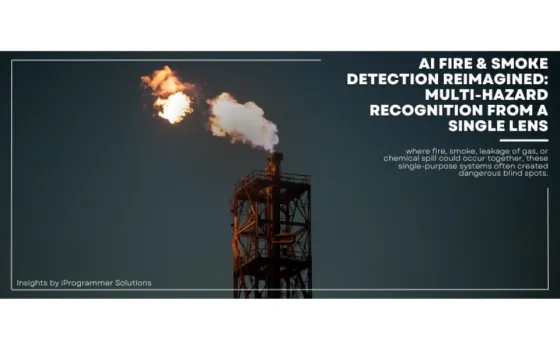Introduction:
Throughout the ages, the railway industry has stood as an indispensable foundation of transportation infrastructure, playing a pivot role in fostering economic prosperity and facilitating seamless connectivity. However, in recent years, the industry has faced numerous challenges ranging from operational inefficiencies to safety concerns. In confronting these issues and propelling a fresh era of innovation, the integration of artificial intelligence has emerged as a transformative catalyst within the railway sphere. The proliferation of AI capabilities has surged in recent times with the availability of data and advanced storage technologies. As per McKinsey and International Union of Railways’ recent report says Railway companies already began to implement AI technologies around key Use cases and further adoption may unlock $13 billion to $22 billion in impact a year, globally. Although the array of potential applications is considerable, for most railway enterprises, AI remains an incipient trend and only a handful of enterprises have deployed any form of AI at scale. Here we can explore the multifaceted impact of AI on the railway industry, spanning areas such as predictive maintenance, safety enhancement, operational optimization, and customer experience improvement.

Predictive Maintenance:
One of the most significant applications of AI in the railway industry is predictive maintenance. Traditional maintenance practices often rely on fixed schedules or reactive approaches, leading to downtime, disruptions, and increased costs.
Predictive Maintenance Scheduling and Diagnostics: Utilizing AI-driven predictive maintenance systems harnesses machine learning algorithms to scrutinize extensive datasets sourced from sensors integrated within trains and infrastructure. Through discerning patterns and aberrations signaling impending breakdowns, these systems facilitate preemptive maintenance actions, mitigating unforeseen downtimes and bolstering asset dependability. As per findings from a study by McKinsey, predictive maintenance holds the potential to slash maintenance expenditures by as much as 25% and curtail downtime by up to 30%. For example, algorithms can predict when critical components such as brakes or bearings are likely to fail, allowing maintenance crews to take preemptive action, thereby improving safety and operational efficiency.
Rail Infrastructure Predictive Maintenance: Utilizing AI techniques can improve the supervision, analysis, and maintenance of railway infrastructure like Tracks, Bridges and Tunnels. Drones equipped with AI powered cameras for visual inspection and advanced imaging techniques like LiDAR and ground-penetrating radar can be used for timely maintenance intervention.
Rolling Stock Maintenance: AI based Rolling Stock predictive maintenance may help to improve efficiency in asset usage as well as to an extent reduce maintenance cost. Pattern Recognition and ML can be used to predict malfunctions in rolling stock components. Also, AI algorithms can be leveraged for predictive lifecycle Modeling and Replacement planning for Rolling stock.
Safety Enhancement:
Ensuring safety remains paramount within the railway industry, where AI technologies play a pivotal role in elevating safety standards. Through the integration of computer vision algorithms with advanced sensor and camera systems, real-time monitoring of tracks becomes not only feasible but highly effective, enabling the swift detection of anomalies such as obstacles or intruders on the railway lines.
Anomaly Detection: AI – powered video analytics systems can monitor stations and trains for security threats, unauthorized access, and suspicious behavior in real-time, ensuring safety and security for passengers and employees.
Collision Avoidance: Furthermore, AI-based predictive analytics can assess the risk of potential collisions or derailments based on historical data and current operating conditions, enabling operators to implement preventive measures promptly. Research by the European Commission indicates that AI-based fault detection systems can improve railway safety by reducing the likelihood of track failures and signal malfunctions.
Driver Assistance Systems: AI- powered driver assistance systems enhance the capabilities of train operators with real-time feedback and alerts regarding potential safety hazards.
Emergency Response Optimization: AI also helps in Emergency Response Optimization, according to research by the international journal of Disaster Risk Reduction, AI-driven emergency response systems improve coordination among rescue teams and enhance the efficiency of evacuation procedures, ultimately saving lives.
NLP for Risk Assessment & Mitigation: Moreover, natural language processing algorithms have the capability to scrutinize incident reports and safety documentation to pinpoint recurring patterns and fundamental reasons behind accidents, thus enabling the execution of focused safety measures and training initiatives. Also, AI-enabled risk assessment and mitigation models enable railway enterprises to prioritize safety investments effectively and allocate resources efficiently.
Operational Optimization:
AI-driven optimization algorithms are reshaping the way railway networks are managed and operated.
Scheduling & Routing: AI algorithms analyze various factors such as passenger demand, train schedules, infrastructure capacity, and maintenance requirements to optimize routes, schedules, and resource allocation. For instance, AI can dynamically adjust train schedules in response to changing demand patterns or unexpected disruptions, minimizing delays, and improving service reliability.
Smart Capacity Management: Moreover, AI-based signaling systems can optimize train spacing and speed, maximizing throughput and capacity utilization while ensuring safety and energy efficiency. By leveraging the capabilities of AI, railway operators stand to achieve notable cost reductions, elevate the quality-of-service delivery, and effectively meet the evolving expectations of passengers.
Crew and Energy Management: Presently, Staff and shift planning optimization and energy efficiency are the spaces where AI adoption maturity levels are relatively high. AI algorithms can optimize energy consumption by trains and infrastructure, by considering factors like speed, route, load, and weather conditions.
Real time Traffic Management: Railway enterprises have already started to partner with technological institutions to explore big data, analytics, and advanced AI for real- time traffic management and monitoring. It can help in automating the tedious task of replanning the train timetables in case of service disruptions due to abnormal weather, accidents, humans, or animals on the tracks etc.
Logistics & Supply Chain Management: AI can help in Cargo logistics and supply chain optimization by predicting demand, optimizing routes, scheduling deliveries, and managing inventory efficiently, which improves supply chain visibility, reduces transit times, and lowers logistics costs.
Passenger Experience Improvement:
In an era characterized by increasing digitization and connectivity, passenger expectations for seamless and personalized travel experiences are higher than ever. Artificial intelligence technologies provide a variety of solutions to elevate the holistic passenger journey within the railway sector. By leveraging AI to deliver personalized and frictionless experiences, railway operators can increase customer satisfaction, loyalty, and retention. AI-powered NLP tools can analyze customer feedback from various sources like, social media, online survey, reviews etc., to identify trends, sentiments, and areas for improvement, which can enable railway enterprises to address passenger concerns proactively and enhance service quality.
Personalized Services: AI-powered systems can analyze passenger data, including travel history, preferences, and demographics, to offer personalized services. For example, AI chatbots can provide tailored travel recommendations, such as nearby attractions, dining options, or connecting transportation services, based on individual preferences.
Real-time Information and Communication: Communication systems powered by artificial intelligence can furnish passengers with up-to-the-minute notifications regarding train timetables, delays, alterations in platforms, and other pertinent details. Chatbots and virtual assistants can answer passenger queries promptly, reducing frustration and uncertainty during travel.
Predictive Maintenance to Reduce Delays: AI algorithms can predict equipment failures and maintenance needs in advance, allowing railway operators to proactively address issues before they cause delays.
Efficient Ticketing and Booking: Ticketing systems enhanced by artificial intelligence streamline the process of purchasing tickets through user-friendly interfaces, personalized suggestions, and anticipatory pricing strategies. Automated fare calculation and ticket validation further expedite boarding processes, reducing queues, and waiting times for passengers.
Crowd Management and Capacity Optimization: AI analytics tools can predict passenger flow patterns and optimize capacity utilization on trains and at stations, by which railway operators can minimize overcrowding, improve boarding experiences, and enhance passenger comfort.
Inclusivity and Multilingual Support: AI technologies can improve accessibility for passengers with disabilities or special needs. For instance, AI-powered signage and navigation systems can provide audiovisual guidance for visually impaired passengers, while speech recognition systems enable hands-free interaction for passengers with mobility impairments. Multilingual chatbots and automated announcements ensure that different language speaking passengers receive essential information and assistance in their preferred language, enhancing inclusivity and convenience.
Integration for connected travel: AI technologies can facilitate seamless integration with other transportation services, such as ridesharing, bike-sharing, or public transit systems. Integration with mobile apps and digital platforms enables passengers to plan multi-modal journeys easily, providing a more convenient and connected travel experience.
Challenges and Considerations:
While the potential benefits of AI intervention in the railway industry are significant, several challenges and considerations must be addressed to realize its full potential. These include,
Information accessibility and accuracy: One of the primary challenges is ensuring the availability and quality of data needed for AI applications. Railway systems generate vast amounts of data from sensors, cameras, ticketing systems, and other sources. However, this data may be fragmented, incomplete, or of varying quality, making it challenging to use effectively for AI algorithms.
Data Integration and Interoperability Challenges: Railway systems often comprise a mix of legacy and modern technologies from different vendors, leading to interoperability issues. Integrating data from disparate systems and ensuring compatibility with AI platforms can be complex and time-consuming.
Regulatory Compliance & Safety Standards: Safety is key in the railway industry, and AI systems must comply with stringent safety regulations and standards. Ensuring the reliability, robustness, and fail-safe operation of AI algorithms poses significant challenges, particularly for safety-critical applications like autonomous train control.
Ethical and legal dilemmas: AI technologies elevate ethical and legal considerations regarding privacy, data security, and accountability. For example, deploying AI-powered surveillance systems on trains and stations may raise privacy concerns among passengers. Furthermore, discerning liability in instances of accidents involving autonomous trains poses legal hurdles that necessitate meticulous examination.
Skill Gap and Training: Deploying AI technologies demands expertise in data science, machine learning, and computer programming. Nevertheless, the railway industry frequently faces a scarcity of professionals possessing the requisite skills. Training existing staff or hiring new talent with the required skills can be costly and time-consuming.
Infrastructure and Connectivity: AI applications often rely on high-speed internet connectivity and robust infrastructure to process and transmit data in real-time. Yet, railway infrastructures might encounter insufficient data availability, especially in remote or rural regions, posing obstacles to the implementation of AI solutions.
Implementation Cost and Return on Investment (ROI): Incorporating AI technologies necessitates substantial initial investments in infrastructure, software development, and staff training. Railway organizations must meticulously assess the prospective return on investment (ROI) of AI expenditures and validate them through concrete advantages such as expense reduction, heightened efficiency, and bolstered safety measures.
Change Management: The integration of AI technologies into conventional railway procedures may encounter opposition from staff members apprehensive about potential job displacement or alterations to their responsibilities. Effective change management strategies and cultural shifts are essential to ensure smooth adoption and acceptance of AI solutions across the organization.
Addressing these practical challenges requires collaboration between railway operators, technology vendors, regulators, and other stakeholders. By surmounting these challenges, the railway sector can harness the complete capabilities of AI to enhance safety, effectiveness, and the passenger journey.
Conclusion:
In summation, the infusion of artificial intelligence (AI) represents a watershed moment in the transformation of the railway sector. By leveraging sophisticated predictive maintenance systems, streamlined scheduling algorithms, and cutting-edge safety protocols, AI interventions hold the promise of profound enhancements in operational efficiency, cost reduction, and overall service quality. Embracing these AI-driven advancements not only elevates the passenger experience but also positions the railway industry on a trajectory towards sustainability and heightened competitiveness. As we forge ahead into the future, the symbiotic collaboration between AI innovation and railway stakeholders is poised to catalyze sweeping changes, heralding an era defined by enhanced connectivity, unwavering reliability, and unprecedented progress in the realm of rail transportation.
References:
https://www.mckinsey.com/industries/travel-logistics-and-infrastructure/our-insights/the-journey-toward-ai-enabled-railway-companies
https://rail-research.europa.eu/news/research-and-innovation-keeps-ai-on-the-right-track/
https://www.sciencedirect.com/science/article/pii/S0968090X22001206
https://www.researchgate.net/publication/359897574_A_Literature_Review_of_Artificial_Intelligence_Applications_in_Railway_Systems



















